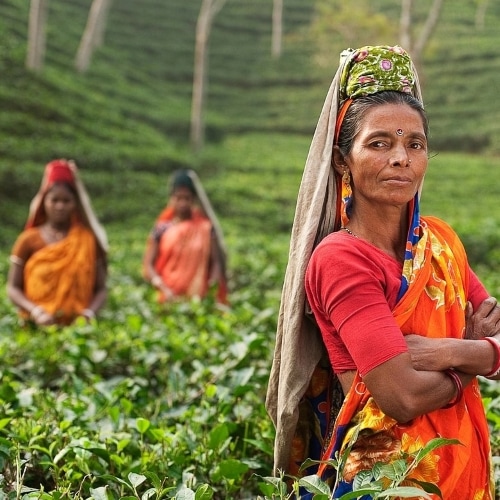Sarah Besky’s ethnographically and historically rich study of the Indian tea industry begins with a deceptively simple question: what makes a good cup of tea? The answer, it turns out, takes us to nineteenth-century British planters and chemists and to twenty-first century Indian bureaucrats and brokers – and most significantly, to the enduring connections between them in pursuit of quality tea. It is this quest for quality that animates Besky’s archival and ethnographic interlocutors – and this book which traces the work of producing quality across factories, plantations, auction houses, tasting rooms, and scientific laboratories. Quality is a subjective concept, one that is difficult to pin down. And yet, quality has been objectified and standardized since the very inception of tea cultivation in Britain’s South Asian colonies.
 This concern with quality is therefore hardly new – rather, its roots can be traced to British imperial political economy and science.
This concern with quality is therefore hardly new – rather, its roots can be traced to British imperial political economy and science.
The force of the book’s argument lies in its deft exploration of how notions of quality are steeped in racialized colonial valuations of people, places, and plants. Besky situates questions of food chemistry, labor recruitment, market-making, blending and auctioning squarely within projects of empire and development. To this day, the industry is infused with imperial nostalgia, the violent legacies of the plantation form, and the extractive monoculture of tea itself.
Quality is a subjective concept, one that is difficult to pin down. And yet, quality has been objectified and standardized since the very inception of tea cultivation in Britain’s South Asian colonies.
Besky’s investigation into quality departs from traditional commodity chain analyses in two distinct ways. First, while much work has studied the two ends of the chain – production or consumption – this book dwells on the “spaces in between: those of brokerage, blending, auctioning, and food chemistry” (p. 2). Second, and more significantly, while focus has largely been on fair-trade and artisanal commodities, this book examines the complex work that goes into making standardized mass-market black tea. Here, quality refers not to distinction or singularity but rather to reliability and sameness. Quality, Besky argues, is most politically and theoretically significant when invoked in the service of reliable and normalizing sensorial experiences (p. 179). Most fascinatingly, Besky shows that it is the variability of tea as a crop that enables its reproducibility in the cup – it tastes the same because what it contains is so different. Counterintuitively, then, these ideas, valuations, and sensoria of quality are produced through experimentation rather than mere replication. Difference and variation are elicited and managed in order to (re)produce coherence.
While focus has largely been on fair-trade and artisanal commodities, this book examines the complex work that goes into making standardized mass-market black tea.
In examining this question, Besky follows the work of anthropologists of capitalism who ponder how it is that commodities are made standard and uniform across the specificity and variability of spaces of production. As Anna Tsing writes, despite each link in the commodity chain being an arena of cultural production, the commodity “must emerge as if untouched by this friction” (Tsing 2005: 51). In the case of tea, the question might be altered to ask how it is that tea – despite the variability of soils and temperatures at the point of production and of water, milk and sugar at the site of consumption – emerges as a familiar and reliable cup?
Besky shows us that this is an enormous and complex project – undertaken not just by plantation laborers, but also by brokers and blenders, agricultural scientists and economic consultants, chemists and auctioneers, among others. But the flavors and textures that make tea a global kitchen staple – bright, dull, stewy, dark, light, brisk, floral – are made possible by the colonial plantation system within which most Indian tea is still produced. The most compelling parts of the book are those in which Besky reminds us that the (re)production of quality reproduces this agro-industrial ecology built on labor extraction and racialized violence.
After all, the plantation is an ecology that contains and constrains the botanical variability of the tea bush into a standardized form.
After all, the plantation is an ecology “that contains and constrains the botanical variability of the tea bush into a standardized form” (p. 6). However, “resources – even monocultured ones – do not “stand alone” as much as they are held in place” (p. 133). The plantation endures because it is maintained. But this maintenance entails both caring and killing. It is generative not only of the material and sensory qualities that make for “good tea” but also of infrastructures of housing and welfare that produce affective entanglements which, in turn, make it a space of home and belonging for laborers and their families. It is these aspirations to quality – of tea and of life – that “keep the monoculture together” (p. 151).
Even beyond the space of the plantation, the very language of quality – its “communicative infrastructures” (p. 54) – are hegemonic ruins of empire. For instance, Besky powerfully shows how ‘teawords’ – the expert lexicon of brokers to describe and assess tea – signify the embodied experiences of white male brokers as aesthetic experts. Not only does this language echo colonial valuations, it reverberates onto sites of production, where the work of women pluckers – using their trained fingers – is evaluated and managed based on these assessments of the taste, smell, and texture of tea. These words, therefore, materially and semiotically connect the (unequal) embodied labor performed by ‘expert’ men and laboring women.
Take the crucial task of blending teas. Besky’s extensive archival research reveals that blending was as much about creating the perfect cup as it was about obscuring ecological difference across the empire. Blending not only eased racial anxieties about safety, health and hygiene within an industrialized and ethnically diverse supply chain, but also made tea uniquely British in its taste. This culminated in nineteenth-century British attempts to mobilize nationalist and racialized sentiments to (unsubtly) label certain teas as ‘Empire Tea’ to be distinguished from both Dutch colonial tea and Chinese green tea. Through this, Besky draws our attention to the intertwined embodiments produced by contact with tea which connects “white metropolitan bodies and the bodies of racially marked field laborers” (p.76).
From these imperial ruins of failing and abandoned plantations emerge not feral ecologies, but a continued expansion of risky monocultures. The logics and structures of the plantation persist even beyond the space of the plantation itself.
Post-liberalization economic reforms in India now aim to challenge these colonial legacies. Yet, this attempt to overcome problems ailing the current system of production is – paradoxically – done through the extension of the tea monoculture beyond the plantation, thus further displacing other crops and ways of life. From these imperial ruins of failing and abandoned plantations emerge not feral ecologies, but a continued expansion of risky monocultures. The logics and structures of the plantation persist even beyond the space of the plantation itself.
This book is a wonderfully layered and immaculately researched exploration of the enduring tastes of empire. As an insightful follow-up to Besky’s first book on meanings of justice on Darjeeling fair-trade tea plantations, this work reminds us of the enduring legacies of plantation worlds, and presents a necessary reckoning with this past in order to reconfigure ideas of what that afternoon cup could and should taste, look, and feel like in the future.
References
Anna Tsing. 2005. Friction: An Ethnography of Global Connection. Princeton: Princeton University Press.
Read Sabine Parrish’s review here.
Read Ishita Dey’s review here.
Featured image by Free-Photos (courtesy of Pixabay)



